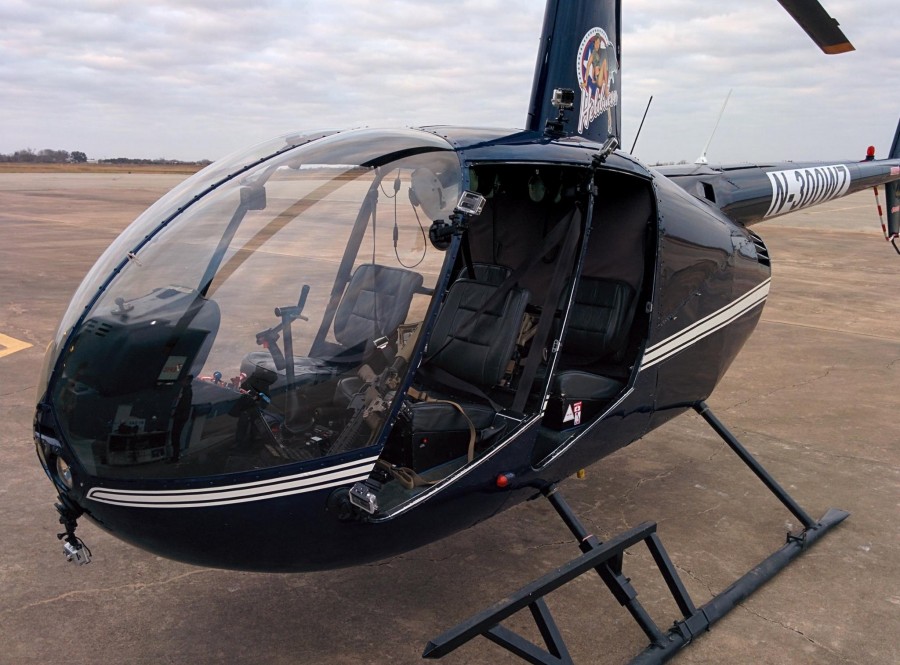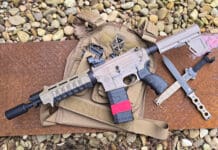I awoke the same way I had countless times before: in a cheap no-frills hotel located in a town I’d never heard of. As predicted, the wake-up call never came and my cell phone’s alarm saved me from over-sleeping. I briefly considered hitting the snooze button and dozing off for another few minutes, but then I remembered why I had driven all this way and only slept around four hours — today was the day I got to shoot stuff from a helicopter . . .
Dave Montana at HeliBacon had contacted me a few weeks prior and invited me out to see what they had to offer, and I just couldn’t refuse. Shooting stuff from a helicopter has always been on my bucket list, and while it wasn’t quite the M60 out of a UH-1 that I had imagined, a Robinson R44 was close enough. So the weekend after SHOT Show I drove out to a small town called Bay City near Houston and deposited myself in a hotel, and waited for dawn.
Bay City is the very definition of a small Texan town — a Whataburger, a Walmart,\ and a few shops were all that marked this spot on the map. But while it may not be notable for its amenities, its hog population is legendary. Texas has a major feral hog problem and Matagorda county is home to one of the heaviest infestations. Situated near a large wildlife preserve, farmers are constantly struggling to keep the porkers out of their crops and away from their animals. So it’s ideal territory for HeliBacon.
After a quick shower I dragged my gear to the car and started making my way to the airport (KBYY). It was still pitch black outside as I maneuvered my way down the country roads, and within minutes I could already see the alternating white and green of the airfield’s rotating beacon despite still being miles away. I pulled into the small airfield parking lot and killed my engine — I was a half an hour early.
The helicopter pilot, John Dumont, was the first to arrive for the day. Born and raised in California, John attended flight school in the area and then decided to strike out on his own. For helicopter pilots the requirement for the number of flight hours to be properly certified is insane, and most pilots spend their early years doing helicopter tours of monuments. As John said, flying the same route over and over again around the exact same monument is excruciatingly boring, and he saw a job with HeliBacon as providing the opportunity to build his hours while doing something fun and interesting. There’s no set route — he’s the man in charge and can do more or less whatever he wants. Once the gabfest had run its course we got down to business — him pre-flighting the helicopter and me sticking it with more GoPro video cameras than you can shake a stick at. Dave and the rest of the crew wandered in a few minutes later, and started trying to explain exactly what they do.
At its heart, HeliBacon isn’t about killing hogs — it’s about entertainment. More specifically, corporate entertainment. Dave says that while a few individuals a month sign up to go for a ride in the helicopter and help solve the hog problem, the majority of their revenue comes from hosting corporate entertainment events. Some of those involve live targets, but Dave says that not every company wants to have a hunting excursion on their expense accounts. Those situations are the reason that HeliBacon not only has an FFL and SOT, but a FEL — a Federal Explosives License. HeliBacon is the only company in the United States that can shoot machine guns out of helicopters at explosives. And, according to Dave, they’ll be adding a 40mm HE grenade launcher to the stable sometime soon. In addition they offer a standalone explosives class (at $250/head) that lets ordinary civilians get an introduction to the chemistry and physics behind explosives.
For those who do want to shoot some hogs from the chopper, HeliBacon is expensive — but worth every penny. Most of the similar helicopter hog depredation outfits not only charge the shooters for the helicopter time, but also charge the ranchers for the service. It makes the fee slightly lower for the shooters, but also means that the chopper company is at the mercy of the rancher’s availability and pocket book. HeliBacon provides their service for free, and in exchange the land owners let them come in and practice their craft whenever the mood strikes them. It means a more expensive ride for the shooters, but there are no blackout dates.
Back in the hangar we were already behind schedule. For the normal experience, the shooters come out to the flight line the night before to get a safety briefing and practice sitting in the helicopter. For me and a British friend of Dave’s (who was going into the British military and Dave was giving him a going-away present), we were given the crash course. But despite the short time frame it was incredibly comprehensive. I’d done something similar with Helicopter tours of Texas, but HeliBacon went above and beyond with the safety briefing even going as far as going over some basic emergency procedures for the helicopter engine itself.
Out on the flight line, the helicopter was almost ready to roll. HeliBacon uses a Robinson R44, a common small helicopter with a 4-seat capacity and a chunky engine. They’ve modified their specific bird for the task, though, by adding a step to the skids. On the last helicopter I shot out of, there was no step and it was hard to get myself positioned to take the shot. With HeliBacon, it felt comfortable and secure even with both legs hanging out the door.
HeliBacon believes what differentiates them from the rest of the hog shooting operations to be the combination of explosives and machine guns. Other places are cheaper, but the experience is what you’re paying for. To that end HeliBacon also provides all of the ammunition you can shoot with the firearm rental — plus a small fee per round for full auto to maintain the weapons.
http://www.youtube.com/watch?v=ubt19wLNcKM
Finally, it was time to go. We strapped ourselves into the helicopter, grabbed the magazines from the crew, and settled in for the flight to the ranch where we would be eliminating the pest problem that day.
As we were flying over the farmland, I finally understood the severity of the issue for the farmers. Entire fields had been destroyed by these feral hogs, looking like a mortar barrage had just passed through the area. I had already squared away my own moral compass when it came to helicopter hog eradication, but seeing the damage firsthand just confirmed my beliefs.
The entire ride over to the ranch, we sat in the helicopter with the guns completely unloaded. It was the first time these guns were being tested in the field (after about 300 rounds of testing), and Dave wanted to make sure that the first people to use them were trained professionals and not paying customers. Apparently Dave has a very lose definition of “trained professional.” The guns in question used a Primary Weapons Systems 16″ upper receiver with a long stroke piston system, and a custom designed full-auto lower receiver manufactured by the FFL/SOT wing of their operation.
As soon as we cleared the fence on the ranch, John gave us the signal to load up. I grabbed a Lancer magazine and smacked it into the gun, racked the charging handle, and swing myself out onto the skid. And then…
Nothing.
For the next forty five minutes, we flew around the ranch and saw nothing but trees and “big pigs you can’t shoot” (cows). There were plenty of hog tracks and signs that hogs were in the area, but the porcine pests were nowhere to be found. They were either playing opossum and waiting for us to leave, or just not there. From the air it was impossible to see hogs that weren’t moving, and John was beginning to suspect that the hogs were onto his game.
It was getting to the point where I was about to ask John to circle some point in the field just so I could get some footage of machine gun shooting, and then as if by magic a pack of hogs appeared in front of the helicopter. John expertly maneuvered the bird into position, I flipped the safety through “SEMI” to “AUTO,” and as soon as the first hog came into the reticle of the EOTech sight I squeezed the trigger.
I have some personal opinions about using a piston system on an AR-15 rifle, but even I have to admit that the PWS upper with the heavy buffer made for the lightest recoiling full auto experience I’ve ever had with a 5.56 gun. It was damn near pleasant, and the light recoil helped keep my sights on target longer. In short, it was the perfect tool for the job. Or rather it would have been, but we experienced a couple malfunctions. I’m pretty sure it was an issue with the gas system not being properly tuned for that specific buffer weight (Dave had fiddled with it the night before), and a quick trip to the range should fix it though.
One interesting difference between HeliBacon and some other companies is that HeliBacon uses a brass deflector instead of a brass catcher. Helicopters are somewhat finicky machines, and don’t take well to small bits of metal being thrown into their inner workings. Like the rotor pedals. Or the blades. Or the pilot’s collar. Most helicopter operators solve this issue by requiring brass catchers on the guns, devices that collect the brass before it gets very far from the ejection port. HeliBacon doesn’t do that. They train their shooters to be almost completely outside the helicopter when shooting, so all that they need to use is something to deflect the brass downwards and they’re good to go. It definitely made the guns less bulky to shoot, and a lot lighter too.
The one part of the experience I didn’t prepare for was communication. In order to spot and track the hogs, communication between everyone on the whirlybid was required. One of us would see something, and then we’d have to be able to communicate the relative position and distance to everyone else. It was challenging with the added noise from the rotor (and the Brit calling out “half ten” instead of ten thirty) but eventually we learned. It’s something that you might want to practice ahead of time, as communicating all of the important information in a single short burst is essential.
Eventually the worst case scenario came to pass: we ran out of ammo. It was time to head back to the airport and get ready for the second half of the day. We had seen what HeliBacon had to offer in terms of its headline offering, but they wanted to make sure I had a taste of the explosives side as well. So after we landed and put all the gear away we packed up and headed to their demolition range for some fun times with explosives. But more on that some other time. . .





No, the “worst case scenario” is what Mas dealt with, the chopper falling out of the sky…
Steelheart
“At its heart, HeliBacon isn’t about killing hogs — it’s about entertainment.”
I’m pretty sure it’s about killing hogs.
I just wanna know when the bacon is being served.
+1
Isn’t this just a recycled or re-edited story? I feel I’ve read this 3-4 times already.
I’ve discussed bits and pieces, but nothing comprehensive. Gotta wring as much content out of it as possible…
Fair enough.
Infinitely jealous
thats freaking awesome. I doubt i can afford one of those trips anytime soon but dang that would be a story. I know the capacity would be limited but i’d love to role a battle rifle like an M14 or FAL instead.
I’d rather have a horse, a pistol, a sword, a lance, and a bunch of watermelons on poles.
I’ve seen a video similar to what you have in mind, but what’s the pistol, lance, and sword for?
All you need are the watemelons and horse, and maybe a midget, or cool whip.
I dig the GoPro EOTech (Aimpoint?) mount.
Is cost per person or per flight? I think I read in one of the other articles it was something like $800? I just got a work bonus burning a hole in my pocket, and no shortage of friends that would be willing to pony up half for hte experience…
Nick, do you go beck to get any hogs you’ve killed and eat them, or are they just left out in the field?
for that matter I saw nothin in your post describing how many, if any, you dropped.
We tallied 25 bodies, and we didn’t pick any up this time.
What a waste; feral hogs are great eating! Best pork ever!
There are plenty more, I promise.
The music was pretty good, but what you really needed was Ride of the Valkyries playing in the background. Loudly.
And napalm. Always napalm.
Looks like fun. A couple of questions for you.
1. Did anyone actually hit any pigs? Saw a lot of shooting in the video, couldn’t really tell what the hit ratio might be.
2. What’s the process for finishing off wounded pigs? Vermin that they are, it’s still not too sporting to let wounded animals wander around. Looks like it would be easy to wound something in that tree cover and not really know it, or lose it in the trees.
They’re not even considered game in Texas, so sport has nothing to do with it.
When you spray for bugs do you care if any are simply wounded, or do you just want them gone? It’s pretty much like that around here with hogs.
Found this video of another company that has some open range land. They use 12ga buck and there are some dudes who do a real hurtin on the pests.
$2500/Hr…Ouch …but that does include 2 hunters.
http://www.youtube.com/watch?v=89UliEiQQyU
Also this video has some shots from a trailing helicopter to get a better perspective sometimes.
Quite often the 12 bores anchored the piggies on the spot. The cross bows, while causing fatal injuries allowed the piggies to keep traveling.
Have to say that this was effective, but I question the propriety of using crossbows. What is he trying to prove? The point is to kill the bastards quickly and efficiently and move on. Crossbows do not seem like the ideal tool for this and are just stroking the shooter’s ego.
You’ll shoot your eye out!
(From A Christmas Story in case anyone doesn’t get it.)
Comments are closed.